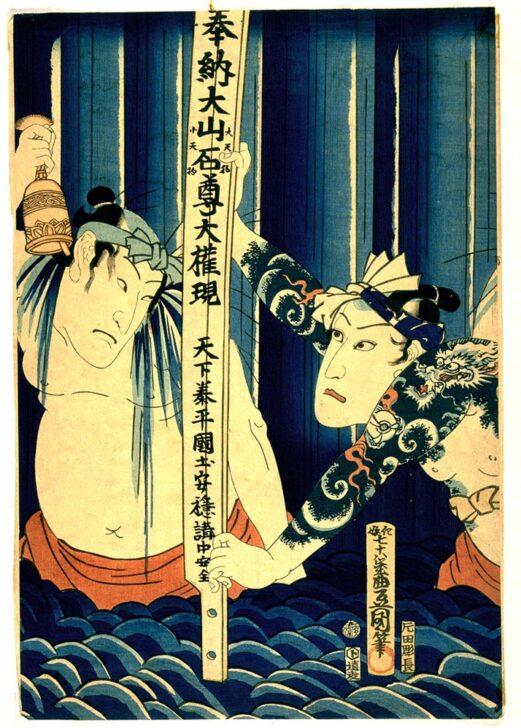Praying for Hits in the Waterfall of Answered Prayers: Kawarazaki Gonjūrō I and Bandō Hikosaburō V
Utagawa Kunisada

Description
Subject Matter:
In this image, kabuki actors Kawarazaki Gonjūrō I and Bandō Hikosaburō V are standing underneath the "Waterfall of Answered Prayers". The Japanese title is an extended pun: arigataki (thankful), taki (waterfall), tsubo (goal, lit. container).
While this image depicts actors, the appearance of the actors hints at a play on popular culture. Though kabuki actors would not have tattoos, the figures in the water sport bold inked designs. This is likely a reference to the bravery and drama of firemen in Edo. Firemen during the Edo period wore reversible uniforms, which after a successful firefight, were turned inside out to present elaborate and colorful designs as they victoriously paraded through the streets. The firemen would often also have these designs tattooed on their torso. Due to the popularity and esteem that firemen gained among the merchant class, shops would sometimes sell jackets made of thin fabric that depicted popular firemen’s designs in order to mimic the intricate tattoos. Additionally, firemen were one of the subjects of kabuki plays and such coats were worn by kabuki actors playing the roles of firemen. In this triptych, the definition of the coat has disappeared, leaving the actors looking as if they were tattooed.
Print artists depicting firemen or actors playing firemen created increasingly detailed and bombastic tattoos in the print designs. Kabuki performances mimicked and tried to one-up these prints in their costuming. Coming full circle, the designs seen in prints and at performances inspired new designs for tattoo artists. The kabuki theater, prints, and tattoos were drawn into a cyclical relationship of borrowing from, attempting to surpass, and influencing each other.
Physical Description:
Two partially clothed men wade in the water in front of a waterfall. The man on the right holds a wooden placquard with both hands. The man on the left stands further back. Water sprays over his shoulders while he rings a bell with his right hand. The man on the right has elaborately tatooed arms.
This is the center portion of a triptych.
To, Enhiko (Publisher's seal); i 3 aratame (Censor's seal); Toyokuni hitsu (Signature)
Usage Rights:
If you are interested in using an image for a publication, please visit https://umma.umich.edu/request-image/ for more information and to fill out the online Image Rights and Reproductions Request Form.